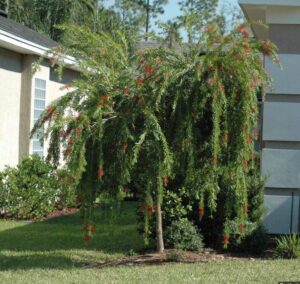S & J Nursery’s Guide to Growing
Weeping Bottlebrush Tree
in the Northeast Florida Landscape
( Callistemon veminalis )
Bottlebrush Origins:
– native to the eastern coast of Australia
Bottlebrush Weeping Exposure:
– full sun to light shade
Weeping Bottlebrush Foliage | Bark:
– foliage on the Weeping Bottlebrush trees are long and slender and can be up to 6 inches ling.
– Weeping bottlebrush foliage tends to be more towards the end of the long hanging branches and not close to the trunk
Weeping Bottlebrush Soil Preference / Salt tolerance:
– moist soils, weeping bottlebrush will not tolerate open areas with high wind or dry soils
– Bottlebrush trees are highly salt tolerant
Weeping Bottlebrush Size Variance:
– Weeping Bottlebrush can reach sizes of 20-30 ft in height and 15 ft wide
Weeping Bottlebrush Growth Habit:
– long hanging branches turn done and hang toward the ground giving the tree a cascading appearance similar to a willow tree
Weeping Bottlebrush Growth Rate:
– extremely fast growth rate
Weeping Bottlebrush Bloom:
– Weeping bottlebrush Callistemon veminalis will bloom heavily in spring and early summer and intermittingly throughout the year. Slender red blooms are 4 to 8 inches in length and resemble a baby’s bottle brush giving the plant its common name
Bottlebrush Weeping Water Requirements:
– moist, well drained soil.
Butterfly or Bird Attracting:
– Weeping Bottlebrush Callistemon veminalis are both butterfly and hummingbird attracting in the North Florida | Jacksonville | St.
Best Uses For Weeping Bottlebrush in the North Florida | Jacksonville | St. Augustine landscape:
– Weeping bottlebrush will make a nice ornamental or small scale tree where supplemental irrigation can be provided or in areas where soil is consistently moist
Care of Weeping Bottlebrush in the North Florida | Jacksonville | St Augustine
Landscape:
– water every day during the establishment period. See watering your newly planted trees for more information. Supplemental irrigation will be needed after the establishment period once the tree has resumed normal growth on a weekly basis if planted in dry or well draining soils.
– prune dead or weakened branches each summer as needed for maximum curb appeal, thin branches out for best appearance and to keep the tree from becoming to top heavy
– staking may be required if training a young tree as it grows
– provide a 1 ft diameter circle of mulched area where grass is kept from growing for each inch of caliper (or diameter) of trunk measured 4 inches from the ground level.
– fertilize each spring with a mixture of Milorganite and a slow real ease poly coated plant food such as Osmocote or Stay Green general purpose plant food, sprinkling the fertilizer around the mulch circle underneath the foliage of the tree

